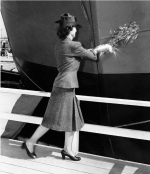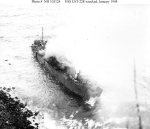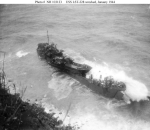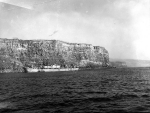Specifications:
| Click On Image For Full Size Image |
Size | Image Description | Source | |
|---|---|---|---|---|

1016022804 |
92k | The ship's sponsor, Mrs. Arthur B. Horton, christens LST-228 as the ship is launched at Chicago Bridge and Iron Co., Seneca, IL.,
25 September 1943.
Photo from picryl.com by U.S. National Archives |
John Spivey | |
 NH 103124 |
61k | LST-228 wrecked in the vicinity of Bahia Angra Island, off Tercina, Azores, where she went ashore, 19 January 1944. LCT-582, visible on LST-228's deck, was also lost in this incident. US Navy photos # NH 103124 and NH 103123 from the collection of John Soule Lynch. Donated (via the National Museum of Naval Aviation) by Pat Livingston, 2005 to the US Naval Historical Center. |
US Navy History and Heritage Command | |
 NH 103123 |
75k | |||
 |
160k | Port broadside view of LST-228 wrecked in the vicinity of Bahia Angra Island, off Tercina, Azores, where she went ashore, 19 January 1944. LCT-582 is still on her deck in this photo, January 1944. US Navy and Marine Corps Museum/Naval Aviation Museum, Photo No. 2001.268.015.003 |
Mike Green | |
USS LST-228
Dictionary of American Naval Fighting Ships (DANFS)
| Commanding Officers | ||
| 02 | LT. Mcllwaine, Julius D. R., USNR | 1943 - ? |
Crew Contact And Reunion Information
U.S. Navy Memorial Foundation - Navy Log
Additional Resources and Web Sites of Interest
The USS LST Ship Memorial
LST Home Port
State LST Chapters
United States LST Association
| Back to the Navsource Photo Archives Main Page | Back To the Amphibious Ship Type Index | Back To The Tank Landing Ship (LST) Photo Index |
| Comments, Suggestions, E-mail Webmaster. |
|
This page is created by David W. Almond and maintained by Gary P. Priolo |